Text
Intercultural Communication 2: Creating a Third Space
In many ways, intercultural communication is similar to communication as we know it: There are senders and receivers, messages, channels and feedback. However, one thing that distinguishes intercultural communication is, you guessed it, the aspect of culture involved in the communication process. Again, cultural differences have enough of an impact on the act of communicating.
Encountering people with various cultures puts us in a space wherein our communication processes can either have inclusive or exclusive outcomes. This should encourage us to find states of mind, or spaces where we can communicate from differing cultural perspectives with a common goal in mind.
Our search for this common state of mind, or common goal, is referred to as the third space or third culture in intercultural communication.

The term third space was coined by Homi Bhaba as a sort of gap, or in-between space among cultures where meanings and ideas are negotiated, and cultures can be re-imagined. This state of mind is abstract, but it produces powerful effects for people, especially minorities: people are able to express themselves without fear of rejection, because in a third space, people actively attempt to become more understanding.
We must continue to create a space where needs can be fulfilled for people, so that intercultural communication can become a rich and rewarding experience.
0 notes
Video
youtube
(START AT 1:04)
Intercultural Communication 2: Towards Intercultural Praxis
We have learned from our last blog that there are different ways to communicate that vary with every culture. Now, we will tackle how to create an understanding of the cultural differences in communication styles. Let’s start with a movie example of cultural differences in action: The Joy Luck Club.
This classic movie from the 1990s shows a prime example of intercultural misunderstanding. Rich, an American, is invited to have dinner at the home of his girlfriend’s Chinese mother, Lindo. You can see that there are subtle non-verbal cues that can show the differences between Chinese and American culture (i.e - In drinking, in taking servings of food, and in misinterpreting subtle Chinese traits such as humbly insulting one’s cooking)! It is clear that
Today, our topic focuses on a much bigger sphere of intercultural communication, which can help us solve small problems like the one presented in the video above.
What are the different issues in Intercultural Communication?
When misunderstandings go unmitigated, they escalate. This applies even to intercultural communication, that when cultural differences are not recognized, they lead to all sorts of issues. Let’s tackle them:
1. Anxiety - This is a state characterized by light to extreme feelings of worry, fear, and insecurity about meeting and interacting with individuals from a different cultural background. It is brought about by the uncertainty in intercultural encounters. Internally, it manifests in light to excessive mental rehearsals over the quality and the outcome of the interaction.
Example: We can see this sort of anxiety within Filipino culture when Filipinos from the Visayas or Mindanao region are regularly criticized for having a certain provincial tilt to their words. This may cause anxiety or a apprehensiveness to speak among certain people due to the fear of revealing their natural accent.
2. Assuming similarity instead of difference - When you assume similarity between cultures you can be caught unaware of important differences. When you have no information about a new culture, it might make sense to assume there are no differences and to behave as you would in your home culture.

Example: By assuming similarity instead of difference, cultures inevitably clash. The book Don’t Take a Bath on Friday makes note of this. We might be able to catch samples of cultural clashes when Westerners refuse to take off their shoes at a Filipino home, or when Westerners do not bow in countries such as Japan! In terms of superstition, think of how horrified a Filipino family would be if a foreigner were to attend a funeral without going somewhere to have a pagpag!
3. Ethnocentrism - This refers to negatively judging aspects of another culture by the standards of one’s own culture. To be ethnocentric is to believe in the superiority of one’s own culture. In fact, superiority or inferiority is relative. All aspects of a particular culture would make sense if you understood that culture. For example, resting under a shade at mid-day makes sense in tropical and subtropical countries. It is not a sign of laziness, as some people from temperate countries might assume.
Example: Though it has yet to be proven that COVID-19 came from bats, world criticism has been given to China for having ‘bat-eaters’ or eaters of any type of animal that moves! This is definitely a form of discrimination based on cultural values. In fact, even when Italy became the epicenter of COVID-19, nobody judged Italian eating habits and behaviors as harshly as they were judged in China.

4. Stereotyping - Stereotypes “are widely held beliefs about a group of people” (Jandt, 2017) and are a form of generalization or a way of categorizing and processing information we receive about others in our daily life. Normally, stereotypes help us to organize and make sense of new experiences. However, there is tendency to overgeneralize a group of people as if a culture and its people have uniform attributes. Jandt reminds us not to ignore nuances in the individualities and identities of people.
Example: Stereotyping is most rampant among people of color, or minorities such as African Americans, Asians, and the like. There are multiple derogatory words for people of color that might only be anecdotally true, but will never be a justifiable reason to keep using stereotypes.

5. Prejudice - Prejudice is a negative attitude toward a cultural group based on little or no experience of it. It is a prejudgment of sorts. Whereas stereotypes are generalizations about a group of people, prejudice is a negative feeling about that group arising from these generalizations.
Example: The picture above, is related to both stereotyping and prejudice. As an extreme form of stereotyping against African Americans, the United States legalized racial segregation that was only removed in the 1960′s, which was approximately only 60 years ago! It is clear that the after-effects of racism have still not been mitigated, as several studies time and time again show lower income and high crime rates are prevalent in African American communities.
6. Discrimination. The behavior that results from stereotyping or prejudice, specifically overt actions to exclude, avoid, or distance oneself from other groups, is called discrimination. Discrimination may be based on racism or any of the other “isms” related to belonging to a cultural group (e.g., sexism, ageism, elitism). One way of thinking about discrimination is that it is the exercise of power based on prejudice, or simply power plus prejudice equals “ism.”
Example: Use of derogatory words such as “N-gger” or “N-gro” to ostracize and invalidate the experiences of African Americans is still common today. It is a fact that history has continued to oppress minorities and still continues to do so through police violence and lack of social support from the state.
How can we resolve issues in intercultural communication?
Kathryn Sorrells, a Communication Studies Professor in the California State University, Northridge (CSUN), takes note of 6 ways that we can mitigate cultural clashes:
Inquiry includes taking an interest in and making a commitment to learn about other cultures, which motivate engagement with other people.
Framing is a continuum of perspective-taking options. Our tendency is to consider, first and foremost, our perspectives and orientations when confronting the world. But Sorrells suggests that it might be better for us to acknowledge that our perspectives are constrained by our frames. To remedy this, we need to educate ourselves about the local and global forces that influence intercultural interactions, like the histories of peoples, for example.
Positioning – Our geographic positions are closely associated with our social and political positions. Some of us may be in a geographic location that affords us direct access to the material and symbolic resources in society. If we acknowledge this central-periphery dichotomy of political, social, and economic reality, we may be in a better position to recognize that people have different levels of access to resources and lack of access impacts on people’s lived realities. We may be able to acknowledge whose voices are dominant, whose voices are silent.
Dialogue – In Sorrells’ words, dialogue offers us opportunities “to stretch ourselves—to reach across—to imagine, experience, and creatively engage with points of view, ways of thinking and being, and beliefs different from our own while accepting that we may not fully understand or come to a common agreement or position” (p. 20). Reflection refers to the capacity for introspection and being able to modify one’s views and behavior based on that reflection.
Action – Sorrells argues that it is not enough that we modify our thoughts and feelings in accordance with the ideals of cultural and political inclusiveness. We must also take action to help promote a socially just, equitable, and peaceful world.
0 notes
Text
Intercultural Communication 2: Non-Verbal Communication
Differences in nonverbal behaviors, also called “cultural displays”, among different groups of people are facilitated by rules about

On our last blog, we discussed verbal communication. Now, we are moving to Non-Verbal Communication. Did you know that Non-Verbal Communication (NVC) comprises a majority of the way that we convey our thoughts?
The popular series Lie To Me is about NVC, in that a detective named Dr. Cal Lightman (based on Dr. Paul Ekman, a real scientist who studied emotions and facial expressions) solves crimes by observing the non-verbal cues of a suspect who could be lying. This show helps us look into the emotions and gestures that we sometimes consciously and unconsciously show to the world, as our form of communication.
What is Non-Verbal Communication?
Nonverbal behaviors include all actions that take place during communication which do not use words, such as facial expressions, eye gaze, posture, use of space, and even tone of voice.
5 Basic Expressions of Non-Verbal Communication
1) To express internal states — i.e. to signal emotions, attitudes, and physiological and other mental states
Ex. Tearing up to show sadness, furrowing one’s eyebrows to show frustration, or smiling widely to show joy
2) To construct identities as physical appearance, comportment, and even clothing oftentimes serve as basis for judging people
Ex. A woman with a designer Prada bag might be rich, or a man with a white coat on may be a doctor
3) To regulate interaction — for example, nodding to indicate agreement
Ex. To give a thumbs up to your friend to show your support
4) To repeat the message — i.e. using gestures to emphasize a point
Ex. To point upwards while giving a religious speech to speak about heaven
5) To substitute for words as when we refer to an object by pointing
Ex. To use one’s hands to indicate a direction

What does this man’s clothing say about him? Your answers and opinions are indicative that you have made a judgment based on non-verbal cues.
Does culture play a role in Non-Verbal Communication?
Yes! Definitely!
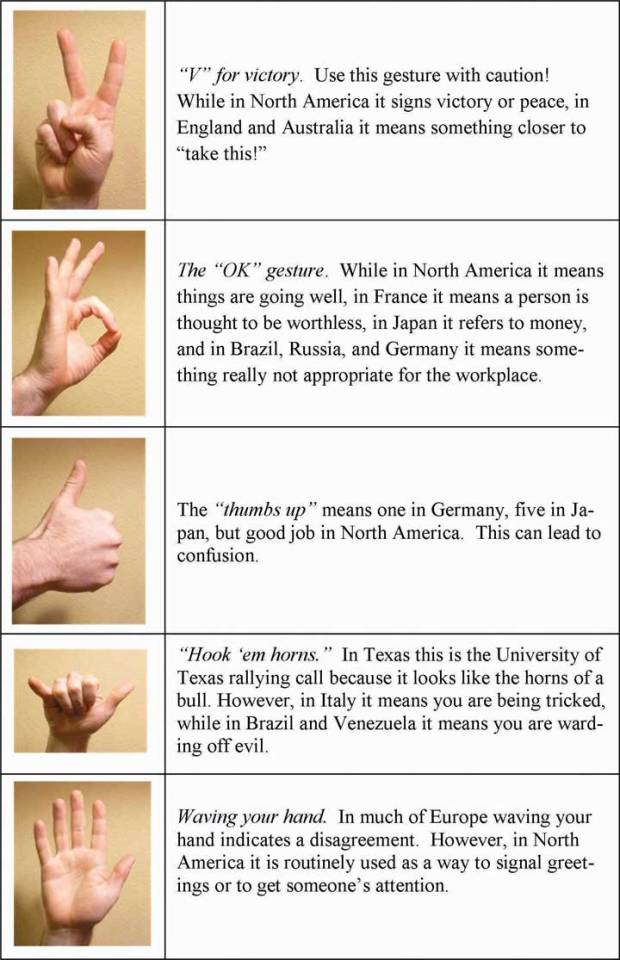
If you look at the above table, different countries have different impressions of certain gestures and signals. This shows us the nuances of non-verbal communication. Differences in nonverbal behaviors, also called “cultural displays”, among different groups of people are facilitated by rules about how to manage and modify emotional expressions according to the situation that people learn from childhood.
Intentionality
Nonverbal communication can be intentional as well as unintentional. It serves as a vehicle of expression or impression.
1. The expressive use refers to when we use substitutes of verbal symbols to deliver information.
2. As a vehicle of impression, nonverbal behaviors become perceptual, with meanings that they are outside of what is being conveyed directly but they are nonetheless indicative of the communicative actor’s motivations.
The Hidden Dimension of Communication
Non-Verbal Communication is referred to as the hidden dimension of communication because if we do not understand non-verbal cues, we can sometimes miss out on the message that someone is trying to tell us.
Ex. A husband and wife are arguing about their marriage.
Wife (crying, sobbing): I am sick and tired of our marriage!
Husband (laughing): Calm down. We can fix this.

It is clear in this situation that there is a mismatch between the husband and the wife. The wife may perceive that her husband is not taking their argument seriously, because he is laughing and telling her to relax, while she is sobbing. The husband, on the other hand, is not taking the wife’s non-verbal cues of crying as a sign of distress.
Why is it so hard to decode Non-Verbal Communication?
One challenge of non-verbal cues is that there may be a mismatch between 2 people. Like our example from the husband and wife, both parties are probably not understanding each other’s reaction. At the same time, non-verbal cues can change meanings.
Ex. A high school student crying because of passing the UPCAT vs. failing the UPCAT.
It is clear that while the non-verbal cue is the same (crying), the student has different reasons for crying. She is crying tears of joy in one situation, and tears of sadness in another.

How can we better understand Non-Verbal Communication?
There are many factors that can cause misunderstanding with non-verbal cues, such as culture, gender, age, and many other individual attributes. However, by assessing our audience carefully, we can convey ourselves better, and at the same time understand our audience better, too!
NON-VERBAL CODES
Nonverbal codes serve as markers of important nonverbal displays that may serve to highlight similarities and differences, thereby allowing us to adjust our actions in order to nurture a positive relationship and foster understanding during intercultural encounters.
Here are 9 Non-Verbal Codes that can help us decode the various nuances of non-verbal communication.
1. Appearance - Physical appearance is the most externally obvious code of nonverbal behavior. It may indicate age, gender, nationality, ethnicity, education, economic status, lifestyle, and attitude. Across cultures, appearance is the basis for judging beauty, and different cultural groups decorate their body with various adornments (e.g. tattoos). How we perceive the other’s physical appearance influences our actions towards them.
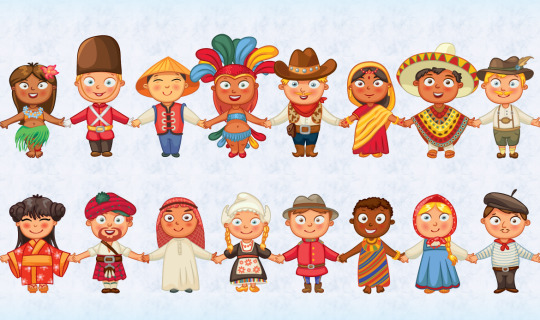
2. Proxemics - This refers to the use of interpersonal space and distance in communication. Cultures differ in their use of personal space, concept of territory, and the meanings assigned to proxemic behavior. The amount of personal space we maintain between ourselves and the people we interact with shows the depth of our relationship with them.
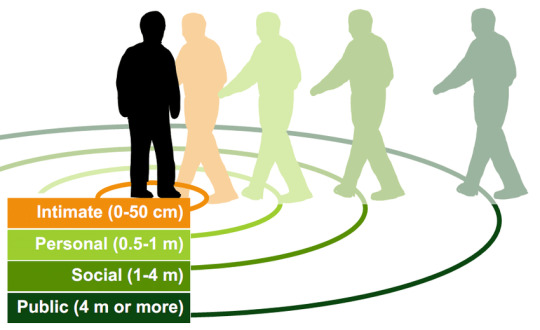
3. Chronemics - This refers to the study of meanings, usage, and communication of time. Different cultures have different concepts of time manifested in terms of punctuality and pace. There are two ways of looking at time: monochronic (M-time) and polychronic (P-time). The monochronic concept of time is linear, sequential, and segmented, such that time is understood to be scarce and must therefore be spent wisely on achieving tasks. The polychronic concept of time results in a leisurely pace.
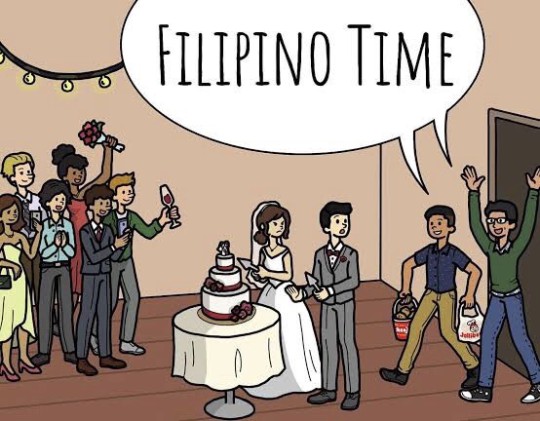
4. Kinesics - Kinesic behavior, which includes posture, gestures, and facial expressions, differs from culture to culture. Gestures are hand movements used to signal speech and to convey verbal meanings. Gestures differ dramatically in meaning, extensiveness, and intensity.
5. Haptics - Also called tactile communication, haptics varies in amount, location, type, and public or private manifestation. Haptics or touch communicates specific emotions like anger, fear, disgust, love, gratitude, and sympathy (Matsumoto & Hwang, 2012). A touch can be accidental, professional, socially polite, friendly, loving, or sexual depending on context and relationship. In a workplace setting, the exchange of touches between colleagues is characterized by professionalism.

6. Oculesics - Oculesics is the study of messages sent by the eyes, including eye contact, blinks, eye movements, and pupil dilation (Samovar et al., 2012). Eye contact and gaze serve a number of functions like expression of thought, monitoring of feedback, indication of attention, and regulation of conversation. There are cultures that value direct eye contact while others practice nominal eye contact.
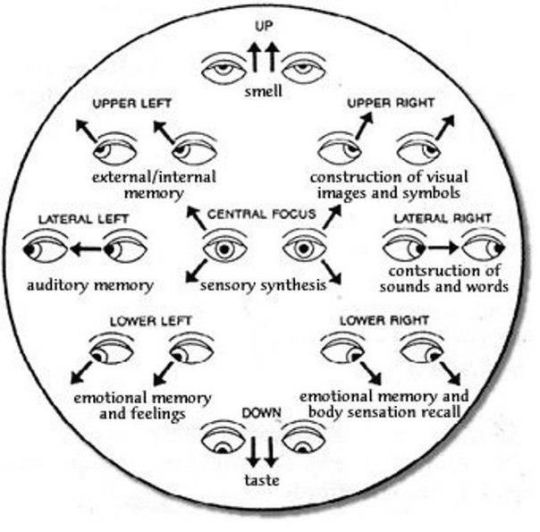
7. Vocalics or Paralanguage - Vocalics or paralanguage refers to the nonverbal elements of the voice, or the tone of the human voice (Samovar et al., 2013). Paralanguage has three categories: vocal qualities, vocal characterizers, and vocal segregates. Vocal qualities include volume, rate, pitch, tempo, resonance, pronunciation, and tone. Vocal characterizers include laughing, crying, moaning, whining, and yawning.

8. Olfactics- Olfactics is the study of interpersonal communication via smell. Olfactics are cultural in two ways: first, certain smells are connected to diet, bodily rituals, and geography; and second, the ability to smell and give valence to certain types of smell are also culturally conditioned. An interesting example is the use of perfumes, which varies among cultures.

9. Silence - Although silence acquires significance and meaning only within the communicative encounter its varying degrees of intensity in the interaction are as meaningful as language. For example, in developing relationships, silence communicates awkwardness and can make people feel uncomfortable. Across cultures, silence plays cognitive, discursive, social, and affective functions. As a social phenomenon, it regulates social distance, impression-formation, social control, and role and power negotiation.

1 note
·
View note
Text
Intercultural Communication 2: Verbal Communication

Did you know that there are different ways to communicate in different cultures? One gesture can mean a good thing in America or the Philippines, but it can also be offensive in Brazil or Spain. These nuances in culture make misunderstandings common between different people.
These misunderstandings can happen in 2 forms of communication, namely:
1. Verbal Communication
2. Non-Verbal Communication.
Let us first focus on Verbal Communication, and then tackle Non-Verbal Communication.
What is Verbal Communication?
Verbal communication refers to the reception, storage, retrieval, manipulation, and generation of linguistic symbols.
-This means that verbal communication is more focused on the way that we speak and convey ideas with our words!
-When either communicator is misunderstood during verbal communication, it is referred to as Communicative Misunderstanding, which is defined as “a potential breakdown point in conversation, or at least a kind of communicative turbulence” by author Muranen.
Communicative Misunderstanding has 2 causes, namely:
1. Inadequate language proficiency - This issue is mostly linguistic, where a communicator is misunderstood or misunderstands due to his or her lack of lexical proficiency or lack of grasp of the language, syntax, or grammar that is being used. We are reminded of a joke with 2 Filipinos in an elevator with an American: Filipino 1: Bababa, ba? (Is the [elevator] going down?) Filipino 2: Bababa. ([It is] going down.) American: WHAT?
It is clear that the American lacks a grasp of the Filipino language to understand such a joke between two Filipinos.

2. Pragmatics - This refers to how the speaker uses words or how words are perceived. This occurs within 3 levels.
Pragmatic mismatch happens when there are significant differences in the locutionary act or what is actually said and its literal meaning, the illocutionary act or how it is said or delivered (which has to do with the speaker’s intent), and the perlocutionary act or the effect of what and how something is said (i.e. the listener's response).
We are reminded of a conversation between 2 angry lovers:
Girlfriend: You are breaking my heart!
Boyfriend: Shall I call 911?
It is clear that the girlfriend intends to show that she is emotionally hurt, while her boyfriend believes that her heart is literally broken.

There are other forms of pragmatic failures:
In a type of pragmatic failure called pragmalinguistic failure, the meaning of an utterance by a second language speaker does not fit with the meaning that a native speaker has of it.
Ex.
Speaker 1, American: May I take advantage of the cellphone plan?
Speaker 2, Filipino: May I avail of the cellphone plan?
It is clear that the American and Filipino are both speaking of buying a cellphone plan, but they convey their words differently.
Another type of pragmatic failure called sociopragmatic failure happens when the hidden rules concerning the applicability of ‘pragmatic concepts’ like politeness, face, directness, and sincerity are not observed because of an incomplete understanding of the degree of social distance, for example.
Ex. - Americans prefer a social distance of about 2-4 ft for people they are not intimate with, while Filipinos and other SEA countries do not mind 0-2 ft of distance between friends.
There are various communication styles that may be different for each culture, as shown below:


1 note
·
View note